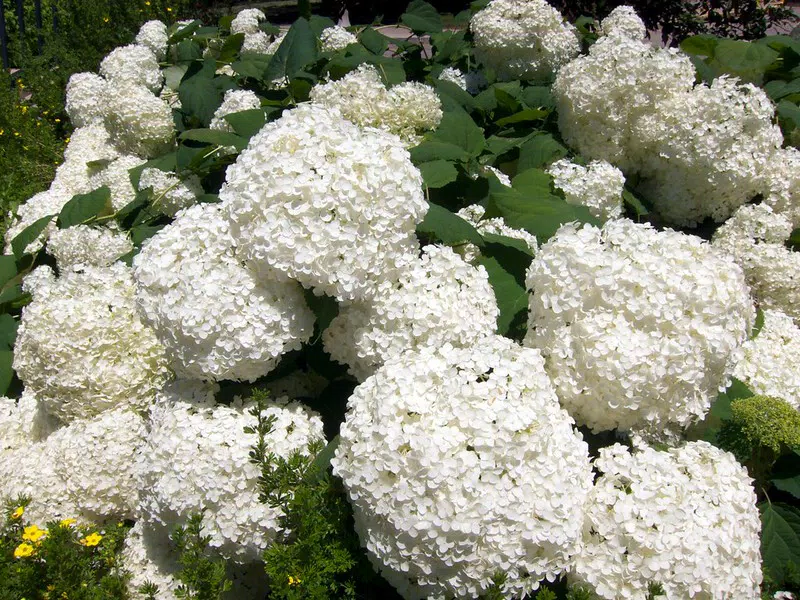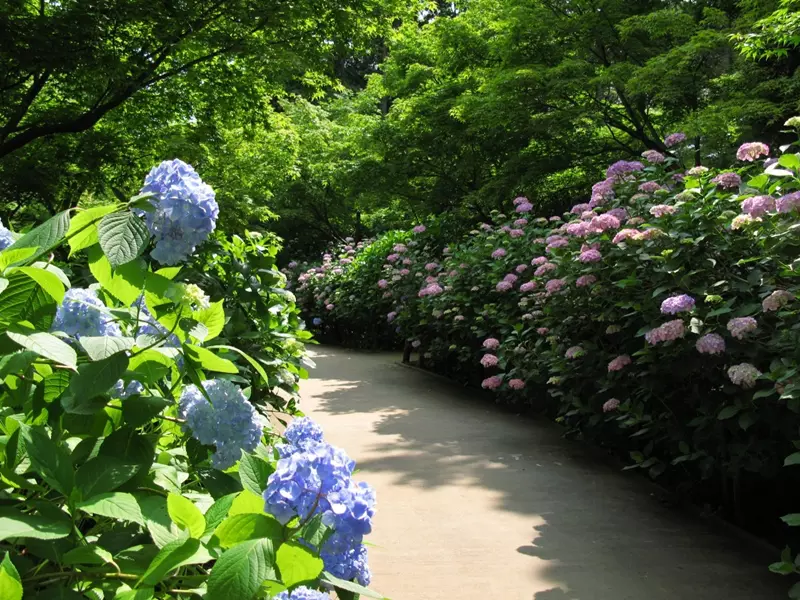Table of Contents
Hydrangeas are a beloved choice for gardens across the USA, admired for their vibrant blooms and versatility. From the iconic mophead varieties to unique panicle types, hydrangeas offer something for every garden style and climate.
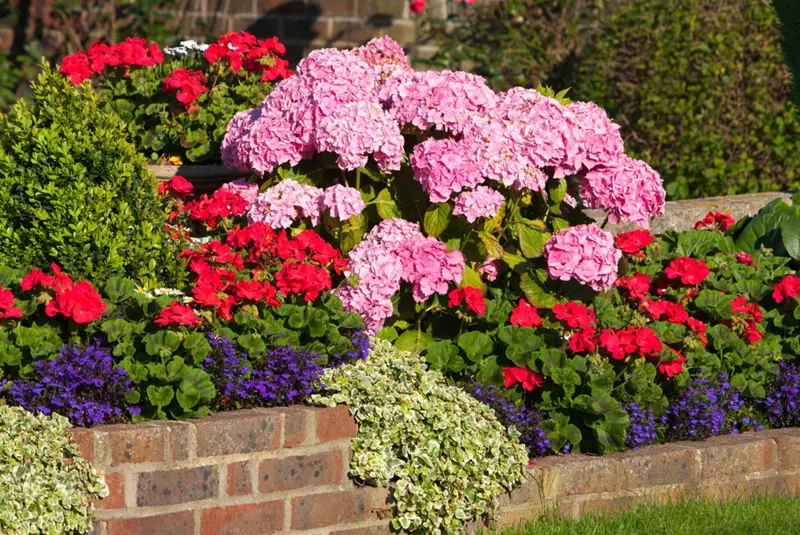 Source: pxhere.com; License: CC0 1.0
Source: pxhere.com; License: CC0 1.0
The 10 Most Popular Hydrangea Varieties
Here are some of the most sought-after hydrangea varieties in the USA, chosen for their beauty, adaptability, and unique characteristics.
1. Endless Summer® Hydrangea
The Endless Summer® Hydrangea is renowned for its ability to bloom on both old and new wood, providing a continuous display of vibrant flowers throughout the growing season. This unique characteristic makes it a favourite among gardeners seeking prolonged floral beauty in their landscapes.
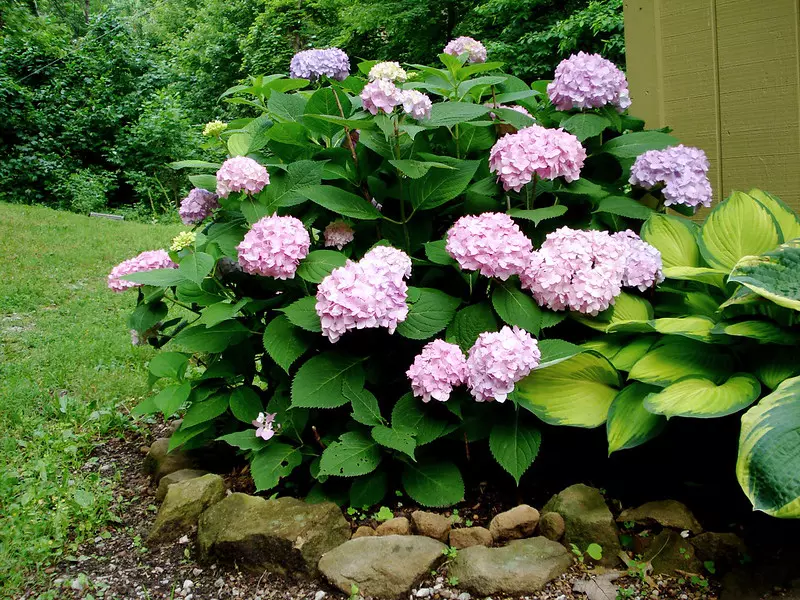 Hydrangea macrophylla 'Endless Summer' - Source: flickr.com; Author: Chiot's Run; License: CC BY-NC 2.0
Hydrangea macrophylla 'Endless Summer' - Source: flickr.com; Author: Chiot's Run; License: CC BY-NC 2.0
Who Should Choose the Endless Summer® Hydrangea?
This hydrangea variety is ideal for:
- Gardeners in Cooler Climates: Hardy in USDA zones 4 through 9, it thrives even in regions with colder winters, offering reliable blooms where other hydrangeas may falter.
- Those Seeking Extended Bloom Periods: Its reblooming nature ensures flowers from early summer through autumn, perfect for those desiring long-lasting garden colour.
- Gardeners Interested in Flower Colour Manipulation: The bloom colour varies with soil pH-acidic soils yield blue flowers, while alkaline soils produce pink-allowing for personalised garden aesthetics.
Ideal Garden Settings in the USA
The Endless Summer® Hydrangea complements various garden designs:
- Foundation Plantings: Its compact size and lush foliage make it suitable for planting near home foundations, adding softness to architectural lines.
- Mixed Borders: It pairs well with perennials and other shrubs, contributing to layered, dynamic landscapes.
- Container Gardening: Suitable for large pots, it can adorn patios and decks, bringing versatility to urban and suburban settings.
Advantages of Endless Summer® Hydrangea
- Extended Blooming Season: Continuous flowering from early summer to autumn enhances garden appeal.
- Cold Hardiness: Performs well in a wide range of climates, including colder regions.
- Flower Colour Versatility: Ability to change bloom colour based on soil pH offers aesthetic flexibility.
Disadvantages of Endless Summer® Hydrangea
- Water Sensitivity: Requires consistent moisture; both overwatering and drought can cause stress.
- Potential for Fewer Blooms in Deep Shade: Insufficient sunlight may reduce flowering.
- Susceptibility to Soil pH Fluctuations: Changes in soil pH can alter bloom colour, which may be undesirable for some gardeners.
Care Guide for Endless Summer® Hydrangea
To ensure optimal growth and flowering:
- Light: Prefers partial shade; morning sun with afternoon shade is ideal, especially in warmer climates.
- Soil: Thrives in fertile, well-drained soil rich in organic matter. Adjust soil pH to influence bloom colour.
- Watering: Maintain consistent soil moisture, avoiding waterlogged conditions. Mulching helps retain moisture and regulate soil temperature.
- Fertilisation: Apply a balanced, slow-release fertiliser in early spring to promote healthy growth and abundant blooms.
- Pruning: Minimal pruning is required. Remove spent blooms and dead or weak stems after flowering to encourage new growth.
- Winter Protection: In colder regions, apply mulch around the base to insulate roots during winter months.
The Endless Summer® Hydrangea is a versatile and resilient choice for gardeners across the USA. Its extended blooming period, adaptability to various climates, and the ability to alter bloom colour make it a standout addition to any garden landscape.
2. Annabelle Hydrangea
The Annabelle Hydrangea (Hydrangea arborescens 'Annabelle') is celebrated for its large, snowball-like white blooms and adaptability across various climates. This deciduous shrub adds elegance to gardens with its impressive floral displays and ease of care.
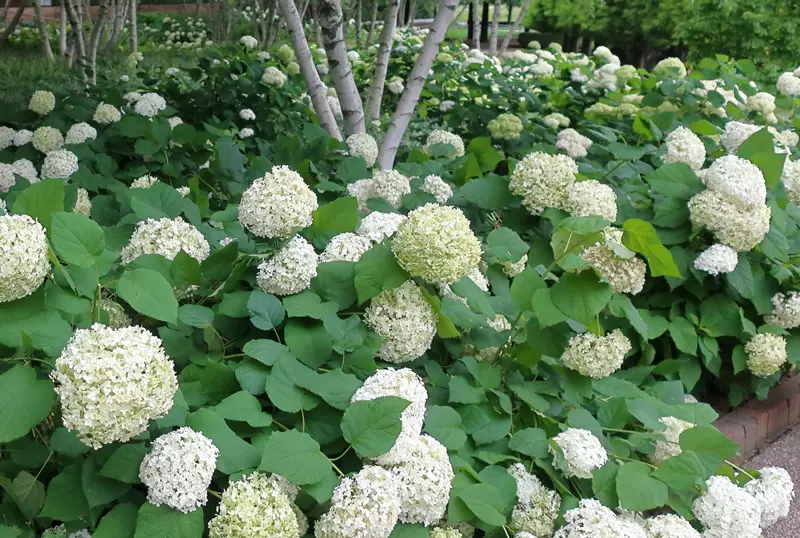 Chicago Botanic Gdn, Regenstein Center 180721 334 Hydrangea arborescens 'Annabelle', Betula populifolia 'Whitespire Senior' - Source: flickr.com; Author: cultivar413; License: CC BY 2.0
Chicago Botanic Gdn, Regenstein Center 180721 334 Hydrangea arborescens 'Annabelle', Betula populifolia 'Whitespire Senior' - Source: flickr.com; Author: cultivar413; License: CC BY 2.0
Who Should Choose the Annabelle Hydrangea?
This hydrangea variety is ideal for:
- Gardeners in Diverse Climates: Hardy in USDA zones 3 through 9, 'Annabelle' thrives in both cold and warm regions, making it a versatile choice for many gardeners.
- Those Seeking Low-Maintenance Plants: With minimal pruning requirements and strong disease resistance, it's suitable for gardeners desiring a beautiful yet undemanding shrub.
- Designers of Cottage and Informal Gardens: Its classic white blooms and bushy habit complement informal garden styles, adding charm and structure.
Ideal Garden Settings in the USA
The Annabelle Hydrangea suits various garden designs:
- Shade Gardens: Preferring partial shade, it's perfect for woodland gardens or shaded borders.
- Foundation Plantings: Its moderate size and attractive foliage make it suitable for planting near home foundations, softening architectural lines.
- Mass Plantings: When planted in groups, 'Annabelle' creates a striking visual impact with its abundant blooms.
Advantages of Annabelle Hydrangea
- Large, Showy Blooms: Produces impressive white flower heads up to 30cm across, providing a stunning focal point in the garden.
- Cold Hardiness: Performs well in a wide range of climates, including colder regions, ensuring reliable blooms.
- Low Maintenance: Requires minimal pruning and is generally resistant to pests and diseases, making it easy to care for.
Disadvantages of Annabelle Hydrangea
- Flopping Stems: Large blooms can cause stems to droop, especially after heavy rain.
- Limited Colour Variety: Unlike some hydrangeas, 'Annabelle' offers only white blooms, which may not suit all colour schemes.
- Potential for Frost Damage: Although hardy, late frosts can damage buds, so protection may be needed in early spring.
Care Guide for Annabelle Hydrangea
To ensure optimal growth and flowering:
- Light: Prefers partial shade; can tolerate full sun if soil remains consistently moist.
- Soil: Thrives in moist but well-drained soil; improve chalky soils with organic matter to support good growth.
- Watering: Maintain consistent moisture, especially during dry periods, to prevent wilting.
- Fertilisation: Apply a balanced, slow-release fertiliser in early spring to promote healthy growth and abundant blooms.
- Pruning: Prune back stems to ground level in late winter or early spring to encourage vigorous new growth and larger blooms.
- Winter Protection: Apply mulch around the base to insulate roots during winter months, especially in colder regions.
The Annabelle Hydrangea is a versatile and resilient choice for gardeners across the USA. Its large, showy blooms, adaptability to various climates, and low maintenance requirements make it a standout addition to any garden landscape.
3. Limelight Hydrangea
The Limelight Hydrangea (Hydrangea paniculata 'Limelight') is renowned for its striking, lime-green to creamy white flower panicles and hardy nature. This deciduous shrub is a favourite among gardeners for its dramatic blooms and versatility, making it an excellent addition to landscapes across the USA.
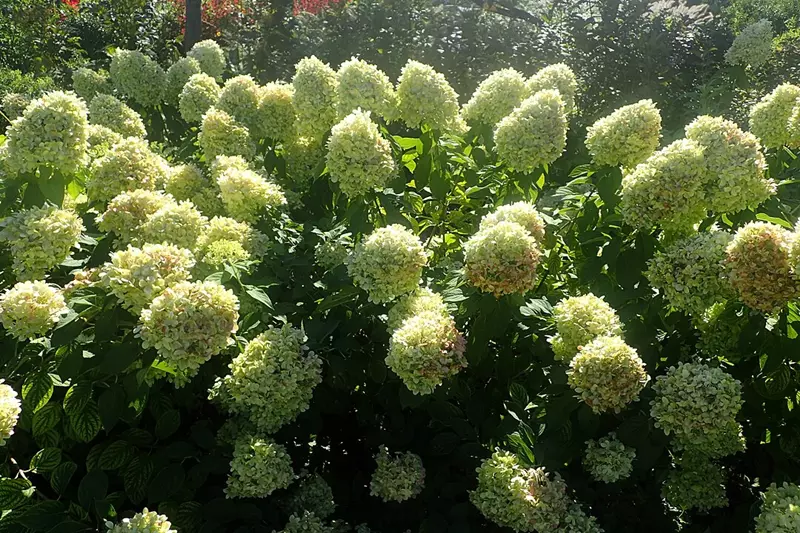 Hydrangea paniculata 'Limelight' at Garfield Park Conservatory - By Krzysztof Ziarnek, Kenraiz - Own work, CC BY-SA 4.0, Link
Hydrangea paniculata 'Limelight' at Garfield Park Conservatory - By Krzysztof Ziarnek, Kenraiz - Own work, CC BY-SA 4.0, Link
Who Should Choose the Limelight Hydrangea?
This hydrangea variety is ideal for:
- Gardeners in Cooler and Warmer Climates: Hardy in USDA zones 3 through 9, it performs reliably in both cold and warm regions.
- Low-Maintenance Enthusiasts: Requiring minimal pruning and offering excellent disease resistance, it's perfect for gardeners seeking ease of care.
- Design-Conscious Gardeners: Its elegant, upright blooms complement both formal and informal garden styles.
Ideal Garden Settings in the USA
The Limelight Hydrangea thrives in various landscapes:
- Mixed Shrub Borders: Adds height and colour to borders, pairing beautifully with perennials and smaller shrubs.
- Privacy Screens: Dense growth and substantial size make it a great choice for natural hedges or privacy barriers.
- Container Gardening: Grows well in large pots, perfect for patios and decks.
Advantages of Limelight Hydrangea
- Extended Blooming Season: Blooms from midsummer through autumn, offering long-lasting garden interest.
- Versatile Colour: Flowers transition from lime-green to creamy white, then blush pink as the season progresses.
- Robust Nature: Thrives in full sun to partial shade and is tolerant of a variety of soil types.
Disadvantages of Limelight Hydrangea
- Drooping Stems: Large, heavy blooms can weigh down stems, especially after rain.
- Limited Winter Interest: Deciduous nature means it loses its leaves in winter, leaving bare stems.
- Space Requirement: Can grow up to 8 feet tall and wide, which might overwhelm smaller gardens.
Care Guide for Limelight Hydrangea
To keep your Limelight Hydrangea healthy and thriving, follow these care tips:
- Light: Prefers full sun to partial shade. In warmer climates, provide afternoon shade to prevent wilting.
- Soil: Grows best in well-drained, moderately fertile soil. Amend heavy clay soils with organic matter for improved drainage.
- Watering: Keep soil consistently moist but not waterlogged, especially during dry spells. Mulching helps retain soil moisture.
- Fertilisation: Apply a balanced, slow-release fertiliser in spring to promote healthy growth and vibrant blooms.
- Pruning: Prune in late winter or early spring to remove dead or weak stems and shape the plant. Heavy pruning can encourage larger blooms.
- Winter Protection: Mulch the base in colder regions to protect the roots from freezing temperatures.
The Limelight Hydrangea is a versatile and resilient shrub that enhances any landscape with its stunning blooms and robust nature. Whether you're designing a formal garden or creating a natural privacy screen, this hydrangea is a reliable and low-maintenance choice for gardeners across the USA.
4. Vanilla Strawberry™ Hydrangea
The Vanilla Strawberry™ Hydrangea (Hydrangea paniculata 'Renhy') is celebrated for its large, cone-shaped flower clusters that transition from creamy white to pink and finally to a rich strawberry red as the season progresses. This deciduous shrub adds dynamic colour and visual interest to gardens, making it a popular choice among gardeners in the USA.
 Vanilla Strawberry™ Hydrangea - By cultivar413 from Fallbrook, California - 190908 194 Chicago Botanic Gdn - Heritage Garden, Japan Bed, Hydrangea paniculata Vanilla Strawberry™ 'Renhy' Panicle Hydrangea, CC BY 2.0, Link
Vanilla Strawberry™ Hydrangea - By cultivar413 from Fallbrook, California - 190908 194 Chicago Botanic Gdn - Heritage Garden, Japan Bed, Hydrangea paniculata Vanilla Strawberry™ 'Renhy' Panicle Hydrangea, CC BY 2.0, Link
Who Should Choose the Vanilla Strawberry™ Hydrangea?
This hydrangea variety is ideal for:
- Gardeners Seeking Seasonal Colour Transformation: The unique colour-changing blooms provide a dynamic and evolving display throughout the growing season.
- Low-Maintenance Enthusiasts: With minimal pruning requirements and strong adaptability, it's suitable for gardeners seeking a beautiful yet undemanding shrub.
- Designers of Cottage and Informal Gardens: Its ever-changing blooms and natural form complement informal garden styles, adding charm and visual interest.
Ideal Garden Settings in the USA
The Vanilla Strawberry™ Hydrangea suits various garden designs:
- Mixed Borders: Adds height and a splash of evolving colour, enhancing the depth and interest of perennial and shrub borders.
- Foundation Plantings: Its moderate size and attractive, changing blooms make it suitable for planting near home foundations, providing seasonal interest.
- Hedging: When planted in a row, it forms a stunning flowering hedge that offers privacy and aesthetic appeal.
Advantages of Vanilla Strawberry™ Hydrangea
- Extended Blooming Season: Flowers from mid-summer to autumn, providing prolonged garden interest.
- Dynamic Colour Changes: Blooms transition from white to pink to red, offering a unique and evolving visual display.
- Cold Hardiness: Thrives in USDA zones 3 through 8, making it suitable for a wide range of climates.
Disadvantages of Vanilla Strawberry™ Hydrangea
- Flopping Stems: Large blooms can cause stems to droop, especially after heavy rain.
- Potential for Sun Scorch: In hotter climates, excessive afternoon sun can lead to leaf scorch; providing partial shade can mitigate this issue.
- Limited Drought Tolerance: Requires consistent moisture; prolonged dry periods can stress the plant and reduce bloom quality.
Care Guide for Vanilla Strawberry™ Hydrangea
To ensure optimal growth and flowering:
- Light: Prefers full sun to partial shade; in warmer climates, providing afternoon shade helps prevent leaf scorch.
- Soil: Thrives in well-drained, slightly acidic to neutral soil rich in organic matter.
- Watering: Maintain consistent moisture, especially during dry periods; mulching helps retain soil moisture and regulate temperature.
- Fertilisation: Apply a balanced, slow-release fertiliser in early spring to promote healthy growth and abundant blooms.
- Pruning: Prune in late winter or early spring to remove dead or weak stems and shape the plant; heavy pruning can encourage larger blooms.
- Winter Protection: In colder regions, apply a thick layer of mulch around the base to protect roots from freezing temperatures.
The Vanilla Strawberry™ Hydrangea is a versatile and eye-catching shrub that transforms gardens with its dynamic colour changes and graceful blooms. Its adaptability, extended blooming season, and ease of care make it a standout choice for gardeners across the USA.
5. Incrediball® Hydrangea
The Incrediball® Hydrangea (Hydrangea arborescens 'Abetwo' Incrediball) is celebrated for its massive, spherical white blooms and sturdy stems. As an improved version of the classic 'Annabelle', this variety offers greater durability and beauty, making it a standout choice for gardens across the USA.
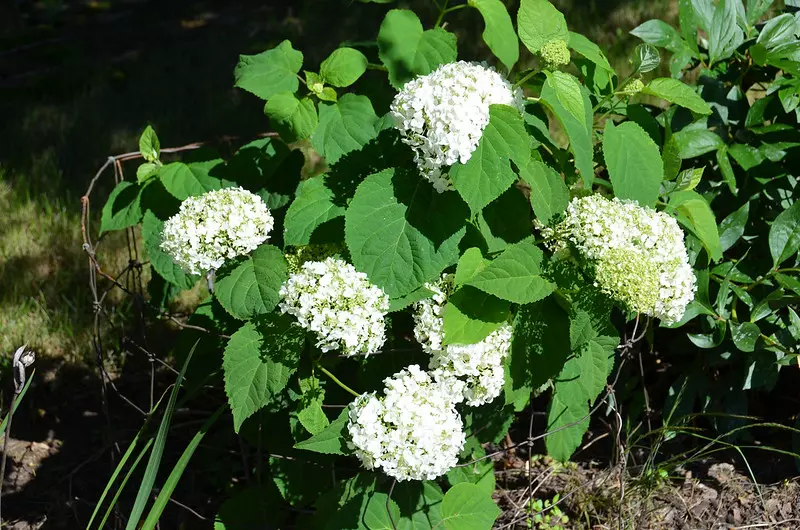 Incrediball® Hydrangea - Source: flickr.com; Author: F. D. Richards; License: CC BY-SA 2.0
Incrediball® Hydrangea - Source: flickr.com; Author: F. D. Richards; License: CC BY-SA 2.0
Who Should Choose the Incrediball® Hydrangea?
This hydrangea variety is ideal for:
- Gardeners Seeking Dramatic Blooms: Its enormous flower heads, some as large as basketballs, provide a striking visual statement in any garden.
- Low-Maintenance Enthusiasts: With minimal pruning needs and excellent disease resistance, it suits those looking for a beautiful yet easy-to-care-for shrub.
- Designers of Formal and Informal Gardens: Its versatile form and showy flowers make it a fitting choice for a wide range of garden styles.
Ideal Garden Settings in the USA
The Incrediball® Hydrangea thrives in various landscapes:
- Foundation Plantings: Perfect for softening architectural lines near home foundations.
- Hedges: When planted in a row, it creates a lush flowering screen ideal for privacy.
- Mixed Borders: Adds height and bold floral accents alongside perennials and other shrubs.
Advantages of Incrediball® Hydrangea
- Massive Blooms: Produces enormous flower heads that remain showy throughout the summer and autumn.
- Sturdy Stems: Strong stems prevent flopping, even under the weight of the large blooms.
- Extended Bloom Time: Flowers reliably from midsummer to autumn, extending the garden's visual appeal.
- Cold Hardiness: Thrives in USDA zones 3 through 8, making it adaptable to a wide range of climates.
Disadvantages of Incrediball® Hydrangea
- Potential for Sunburn: In hot climates, leaves may scorch if exposed to intense afternoon sun.
- Requires Moisture: Consistent watering is essential to prevent stress and ensure optimal bloom performance.
- Limited Colour Options: Blooms are exclusively white, which may not suit all garden palettes.
Care Guide for Incrediball® Hydrangea
To ensure optimal growth and performance, follow these care tips:
- Light: Prefers full sun to partial shade; in warmer regions, provide afternoon shade to prevent leaf scorch.
- Soil: Grows best in well-drained, fertile soil enriched with organic matter.
- Watering: Keep soil consistently moist, especially during dry periods. Mulch to retain moisture and regulate soil temperature.
- Fertilisation: Apply a balanced, slow-release fertiliser in early spring to promote healthy growth and abundant blooms.
- Pruning: Prune in late winter or early spring to remove dead or weak stems and encourage vigorous growth. Heavy pruning can enhance bloom size.
- Winter Protection: In colder zones, apply mulch around the base to protect roots from freezing temperatures.
The Incrediball® Hydrangea is an exceptional choice for gardeners seeking bold, low-maintenance blooms. Its massive flower heads, sturdy stems, and adaptability make it a standout option for landscapes across the USA. Whether used as a focal point, a hedge, or part of a mixed border, this hydrangea brings elegance and impact to any garden.
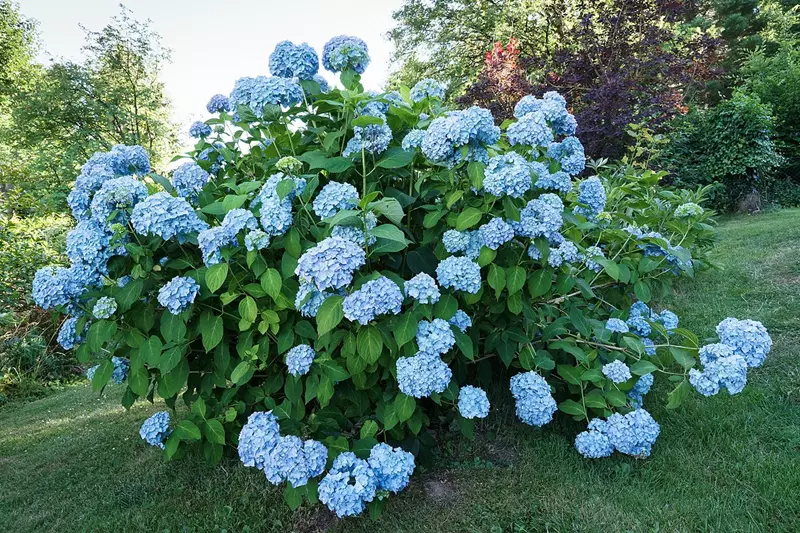 Blooming Hydrangea macrophylla 'Nikko Blue' - By Neptuul - Own work, CC BY-SA 4.0, Link
Blooming Hydrangea macrophylla 'Nikko Blue' - By Neptuul - Own work, CC BY-SA 4.0, Link
Who Should Choose the Nikko Blue Hydrangea?
This hydrangea variety is ideal for:
- Gardeners Seeking Vibrant Blue Blooms: Its striking blue flowers provide a captivating focal point in any garden setting.
- Those Looking for a Reliable Shrub: Known for its dependability, 'Nikko Blue' offers consistent performance with minimal maintenance.
- Designers of Cottage and Coastal Gardens: Its soft yet dramatic appearance complements traditional cottage or coastal garden styles.
Ideal Garden Settings in the USA
The Nikko Blue Hydrangea thrives in various landscapes:
- Foundation Plantings: Its moderate size and attractive blooms make it suitable for planting near home foundations, adding seasonal interest.
- Hedges: When planted in a row, it creates a colourful hedge that offers both privacy and aesthetic appeal.
- Mixed Borders: Adds height and visual interest, complementing perennials and other shrubs in garden borders.
Advantages of Nikko Blue Hydrangea
- Vibrant Blue Blooms: Produces large, vivid blue flowers, especially in acidic soils.
- Extended Blooming Season: Flowers from early summer through autumn, providing long-lasting beauty.
- Adaptable to Soil pH: While it prefers acidic soils for blue blooms, it can also produce pink flowers in alkaline soils, offering versatility in flower colour.
Disadvantages of Nikko Blue Hydrangea
- Cold Sensitivity: Less hardy in colder climates; may suffer winter damage in USDA zones below 6.
- Requires Consistent Moisture: Needs regular watering; drought conditions can stress the plant and reduce bloom quality.
- Potential for Colour Variation: Flower colour can change based on soil pH, which may not align with gardener expectations.
Care Guide for Nikko Blue Hydrangea
To ensure optimal growth and flowering:
- Light: Prefers partial sun; about 4-6 hours of sunlight per day, ideally in the morning to avoid the intense afternoon sun.
- Soil: Thrives in well-drained, slightly acidic to neutral soil rich in organic matter.
- Watering: Maintain consistent moisture, especially during dry periods; aim to provide about one inch of water per week.
- Fertilisation: Apply a balanced, slow-release fertiliser in early spring to promote healthy growth and abundant blooms.
- Pruning: Prune in late winter or early spring to remove dead or damaged branches and encourage new growth.
- Winter Protection: In colder regions, apply mulch around the base to protect roots from freezing temperatures.
- Adjusting Flower Colour: To maintain blue blooms, ensure soil pH is acidic (below 6.5); for pink blooms, a more alkaline soil is required.
The Nikko Blue Hydrangea is a versatile and eye-catching shrub that enhances gardens with its vibrant blooms and lush foliage. Its adaptability, extended blooming season, and ease of care make it a standout choice for gardeners across the USA.
7. Twist-n-Shout® Hydrangea
The Twist-n-Shout® Hydrangea (Hydrangea macrophylla 'PIIHM-I'), part of the Endless Summer® series, is celebrated for its reblooming lacecap flowers and vibrant autumn foliage. This deciduous shrub offers a dynamic presence in gardens across the USA, captivating gardeners with its seasonal transformations.
 Hydrangea macrophylla 'Twist and Shout' bush - Source: pexels.com; Author: Magda Ehlers; License: Pexels licence - Free to use
Hydrangea macrophylla 'Twist and Shout' bush - Source: pexels.com; Author: Magda Ehlers; License: Pexels licence - Free to use
Who Should Choose the Twist-n-Shout® Hydrangea?
This hydrangea variety is ideal for:
- Gardeners Seeking Continuous Blooms: Its ability to rebloom from late spring through autumn ensures a prolonged display of colour.
- Designers of Ornamental Gardens: The lacecap flowers and red stems add unique visual interest, enhancing both formal and informal garden designs.
- Low-Maintenance Enthusiasts: With minimal pruning requirements and adaptability to various soil types, it is suitable for gardeners seeking beauty with ease.
Ideal Garden Settings in the USA
The Twist-n-Shout® Hydrangea thrives in diverse landscapes:
- Foundation Plantings: Its moderate size and attractive blooms make it suitable for planting near home foundations, adding seasonal interest.
- Mixed Borders: Adds height and visual interest, complementing perennials and other shrubs in garden borders.
- Container Gardening: Its compact form makes it suitable for large pots, allowing versatility in placement and mobility.
Advantages of Twist-n-Shout® Hydrangea
- Reblooming Capability: Flowers on both old and new wood, providing continuous blooms throughout the growing season.
- Seasonal Foliage Colour: Leaves transition to deep red in autumn, offering multi-seasonal interest.
- Soil pH-Dependent Bloom Colour: Flower colour varies with soil pH-acidic soils yield blue blooms, while alkaline soils produce pink blooms, allowing for customisation.
- Hardiness: Suitable for USDA zones 4 through 9, accommodating a wide range of climates.
Disadvantages of Twist-n-Shout® Hydrangea
- Water Sensitivity: Requires consistent moisture; drought conditions can stress the plant and reduce bloom quality.
- Potential for Winter Damage: In colder regions, harsh winters may damage buds, potentially affecting bloom production.
- Soil pH Management: Achieving desired bloom colour requires monitoring and adjusting soil pH, which may require additional effort.
Care Guide for Twist-n-Shout® Hydrangea
To ensure optimal growth and flowering:
- Light: Prefers full sun to partial shade; in warmer climates, providing afternoon shade helps prevent leaf scorch.
- Soil: Thrives in well-drained, fertile soil rich in organic matter.
- Watering: Maintain consistent moisture, especially during dry periods; mulching helps retain soil moisture and regulate temperature.
- Fertilisation: Apply a balanced, slow-release fertiliser in early spring to promote healthy growth and abundant blooms.
- Pruning: Minimal pruning is required; remove spent blooms and damaged stems after flowering to encourage new growth.
- Winter Protection: In colder regions, apply mulch around the base to insulate roots during harsh winters.
The Twist-n-Shout® Hydrangea is a versatile and striking choice for gardeners seeking extended blooms and unique aesthetics. Its lacecap flowers, seasonal foliage transformations, and ease of care make it a standout in gardens across the USA.
8. Oakleaf Hydrangea
The Oakleaf Hydrangea (Hydrangea quercifolia) is a deciduous shrub native to the southeastern United States, renowned for its distinctive oak-shaped leaves and striking, cone-shaped flower panicles. This versatile plant offers year-round interest, with vibrant autumn foliage and exfoliating bark that adds winter appeal. Its adaptability and unique characteristics make it a cherished addition to gardens across the USA.
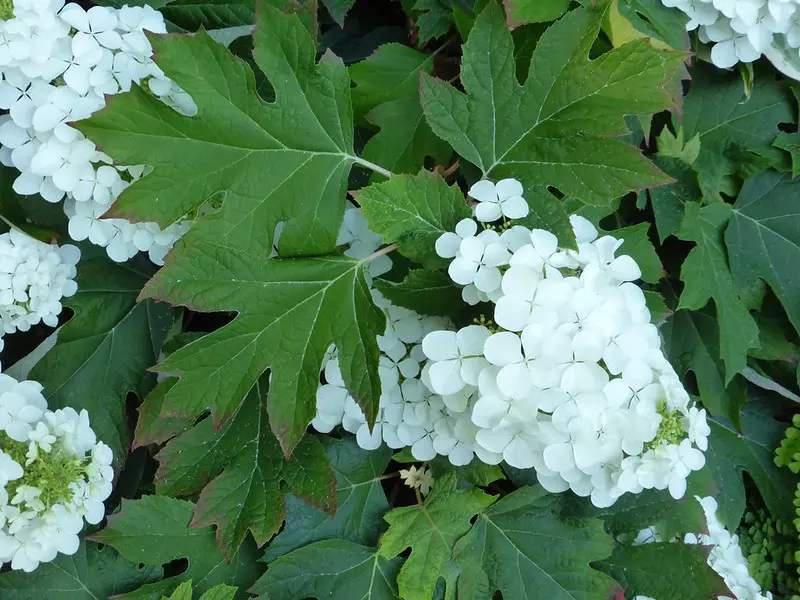 Source: freepik.com; Author: UBC Botanical Garden; License: CC BY-NC-SA 2.0
Source: freepik.com; Author: UBC Botanical Garden; License: CC BY-NC-SA 2.0
Who Should Choose the Oakleaf Hydrangea?
This hydrangea variety is ideal for:
- Gardeners Seeking Seasonal Interest: With its multi-seasonal appeal, including summer blooms and autumn foliage, it provides dynamic beauty throughout the year.
- Native Plant Enthusiasts: As a North American native, it supports local ecosystems and promotes biodiversity.
- Low-Maintenance Gardeners: Its relative drought tolerance and minimal pruning requirements make it suitable for those seeking an easy-care shrub.
Ideal Garden Settings in the USA
The Oakleaf Hydrangea thrives in various landscapes:
- Woodland Gardens: Prefers partial shade and complements naturalistic settings with its textured foliage and form.
- Mixed Shrub Borders: Adds height and visual interest, pairing well with other shrubs and perennials.
- Foundation Plantings: Its moderate size and ornamental features enhance the aesthetic appeal near home foundations.
Advantages of Oakleaf Hydrangea
- Four-Season Interest: Offers visual appeal throughout the year with blooms, foliage, and bark.
- Drought Tolerance: More drought-resistant than other hydrangea species once established.
- Adaptability: Thrives in a range of soil types and light conditions, from full sun to partial shade.
Disadvantages of Oakleaf Hydrangea
- Susceptibility to Root Rot: Requires well-drained soil to prevent root rot diseases.
- Potential for Leaf Spot: May experience foliar diseases in humid conditions; proper spacing and air circulation are essential.
- Cold Sensitivity: In USDA Zone 5, flower buds may suffer damage from late spring frosts, potentially reducing bloom production.
Care Guide for Oakleaf Hydrangea
To ensure optimal growth and flowering:
- Light: Prefers partial shade; tolerates full sun if provided with adequate moisture.
- Soil: Thrives in well-drained, fertile soil with a slightly acidic to neutral pH.
- Watering: Maintain consistent moisture, especially during establishment; once established, it exhibits moderate drought tolerance.
- Fertilisation: Apply a balanced, slow-release fertiliser in early spring to promote healthy growth and abundant blooms.
- Pruning: Minimal pruning is required; remove dead or damaged branches after flowering to maintain shape and vigour.
- Winter Protection: In colder regions, apply mulch around the base to insulate roots and protect against temperature fluctuations.
The Oakleaf Hydrangea is a versatile and resilient shrub that enhances gardens with its unique foliage, attractive blooms, and year-round interest. Its adaptability to various garden settings and ease of care make it a valuable addition to landscapes across the USA.
9. Little Lime® Hydrangea
The Little Lime® Hydrangea (Hydrangea paniculata 'Jane') is a compact cultivar celebrated for its lime-green blooms that gradually transition to pink and burgundy hues as the season progresses. With a height of 3 to 5 feet, it delivers the grandeur of its larger counterpart, 'Limelight', in a smaller, more versatile package, making it an excellent choice for gardens across the USA.
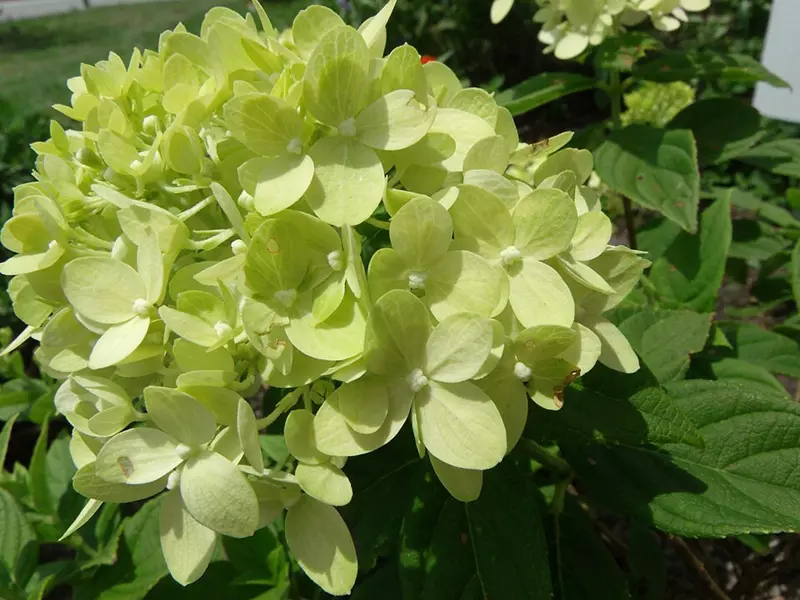 Mini limelight hydrangea - Source: By MChance666 - Own work, CC BY-SA 4.0, Link
Mini limelight hydrangea - Source: By MChance666 - Own work, CC BY-SA 4.0, Link
Who Should Choose the Little Lime® Hydrangea?
This hydrangea variety is ideal for:
- Gardeners with Limited Space: Its compact size makes it suitable for smaller gardens, urban settings, and container planting.
- Seasonal Colour Enthusiasts: Little Lime® provides dynamic visual interest with its evolving flower colours, perfect for multi-seasonal displays.
- Low-Maintenance Gardeners: Requiring minimal care, it is a great option for those seeking an easy-to-grow yet striking shrub.
Ideal Garden Settings in the USA
The Little Lime® Hydrangea thrives in various landscapes:
- Mixed Borders: Adds texture and seasonal colour, complementing other perennials and shrubs.
- Foundation Plantings: Enhances home exteriors with its tidy form and vibrant blooms.
- Container Gardens: Perfect for large pots, offering versatility in placement and mobility.
Advantages of Little Lime® Hydrangea
- Extended Blooming Period: Flowers from midsummer to autumn, providing long-lasting beauty.
- Hardy and Adaptable: Thrives in USDA zones 3 to 8 and tolerates a variety of climates and soil conditions.
- Compact Size: Its manageable height and width make it ideal for smaller spaces without sacrificing visual impact.
- Sturdy Stems: Unlike some hydrangeas, its strong branches prevent blooms from drooping.
Disadvantages of Little Lime® Hydrangea
- Water Dependency: Requires consistent moisture, especially in dry or hot climates.
- Limited Shade Tolerance: While it thrives in full sun, excessive heat may necessitate afternoon shade in warmer regions.
- Not Pest-Proof: Though generally resistant, it can attract aphids or spider mites in suboptimal conditions.
Care Guide for Little Lime® Hydrangea
Follow these tips for optimal growth and blooming:
- Light: Prefers full sun to partial shade. In hot climates, provide afternoon shade to prevent leaf scorch.
- Soil: Thrives in well-drained, fertile soil; enrich the soil with organic matter for best results.
- Watering: Keep soil consistently moist, particularly during dry spells. Mulching around the base helps retain moisture.
- Fertilisation: Apply a balanced, slow-release fertiliser in early spring to promote healthy growth and abundant blooms.
- Pruning: Prune in late winter or early spring while the plant is dormant. Remove dead or damaged stems to encourage vigorous growth.
- Winter Care: Mulch the base to protect roots in colder regions and ensure robust regrowth in spring.
The Little Lime® Hydrangea is a versatile, hardy shrub that brings vibrant colour and structural beauty to gardens of all sizes. Its compact nature, ease of care, and dynamic seasonal appeal make it a top choice for gardeners across the USA.
10. Tardiva Hydrangea
The Tardiva Hydrangea (Hydrangea paniculata 'Tardiva') is a deciduous shrub renowned for its late-season blooms and hardy nature. With its conical clusters of white flowers that gradually turn purplish-pink, it adds visual interest to gardens from midsummer through autumn. Its adaptability and resilience make it a popular choice among gardeners in the USA.
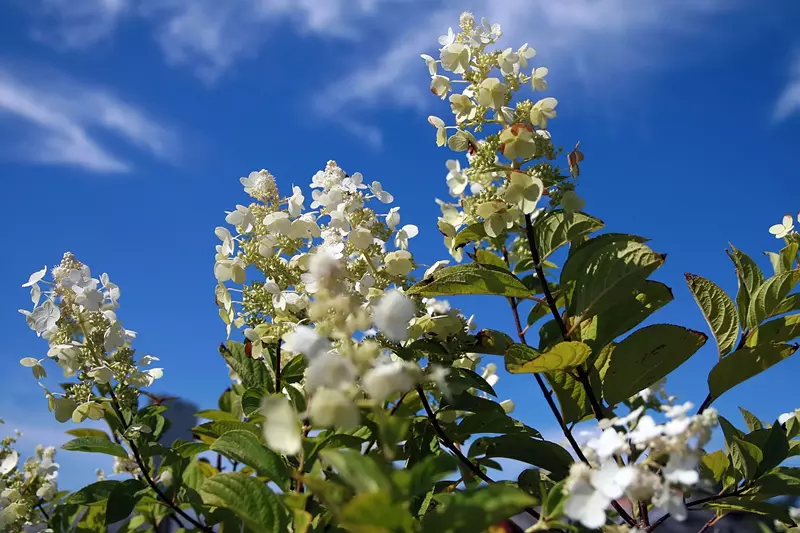 Tardiva Hydrangea - Source: By Photo by David J. Stang - source: David Stang. First published at ZipcodeZoo.com, CC BY-SA 4.0, Link
Tardiva Hydrangea - Source: By Photo by David J. Stang - source: David Stang. First published at ZipcodeZoo.com, CC BY-SA 4.0, Link
Who Should Choose the Tardiva Hydrangea?
This hydrangea variety is ideal for:
- Gardeners Seeking Late-Season Blooms: 'Tardiva' blooms later than many other hydrangea varieties, providing fresh flowers when others have faded.
- Those in Cooler Climates: Its hardiness makes it suitable for USDA zones 3 through 8, thriving in a range of temperatures.
- Low-Maintenance Landscapes: 'Tardiva' is relatively easy to care for, requiring minimal pruning and maintenance.
Ideal Garden Settings in the USA
The Tardiva Hydrangea thrives in various landscapes:
- Hedges and Privacy Screens: Its upright growth habit and height (up to 12 feet) make it suitable for creating natural barriers.
- Mixed Shrub Borders: Adds height and late-season colour, complementing other perennials and shrubs.
- Specimen Plantings: Serves as a focal point in the garden due to its striking blooms and form.
Advantages of Tardiva Hydrangea
- Late Blooming Period: Provides floral interest from late summer into autumn, extending the garden's blooming season.
- Hardiness: Tolerant of cold climates, suitable for USDA zones 3 through 8.
- Adaptability: Thrives in full sun to partial shade and tolerates a variety of soil types.
- Low Maintenance: Requires minimal pruning and is relatively pest-resistant.
Disadvantages of Tardiva Hydrangea
- Size Considerations: Can grow quite large (up to 12 feet tall and 10 feet wide), which may not be suitable for small gardens.
- Water Requirements: Needs consistent moisture, especially during establishment and in dry periods.
- Potential for Flopping: Without proper pruning, branches may become leggy and unable to support heavy blooms.
Care Guide for Tardiva Hydrangea
To ensure optimal growth and flowering:
- Light: Prefers full sun to partial shade; in hotter climates, some afternoon shade can be beneficial.
- Soil: Thrives in moist but well-drained soil; prefers slightly acidic to neutral pH (6.1 to 7.0).
- Watering: Maintain consistent moisture, especially during dry spells; avoid waterlogged conditions to prevent root rot.
- Fertilisation: Apply a balanced, slow-release fertiliser in early spring to promote healthy growth and abundant blooms.
- Pruning: Prune in late winter or early spring before new growth emerges; remove dead or weak stems to encourage vigorous blooming.
- Mulching: Apply a layer of mulch around the base to retain soil moisture and regulate temperature.
The Tardiva Hydrangea is a versatile and resilient shrub that brings late-season beauty to gardens with its showy blooms and hardy nature. Its adaptability to various garden settings and ease of care make it a valuable addition to landscapes across the USA.
Tips for Caring for Your Hydrangeas
- Soil: Maintain the appropriate pH for your hydrangea variety. Acidic soils produce blue flowers, while alkaline soils yield pink blooms.
- Water: Hydrangeas thrive with consistent moisture but ensure good drainage to prevent root rot.
- Sunlight: Most varieties prefer morning sun and afternoon shade, although panicle types can handle more sun.
- Pruning: Prune dead or weak stems to encourage healthy growth and fuller blooms.
Whether you prefer dramatic panicle blooms or the charm of classic mopheads, hydrangeas are a versatile choice for any garden. With the right care and selection, you can enjoy these stunning flowers throughout the season.
About the Author

Richard Seres-Nagy is a passionate gardener with over 20 years of experience in hydrangea care. He founded Hydrangea Library to share expert advice, step-by-step guides, and practical tips for fellow gardening enthusiasts.
Read More
